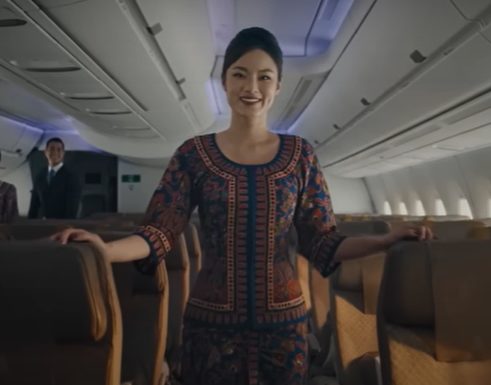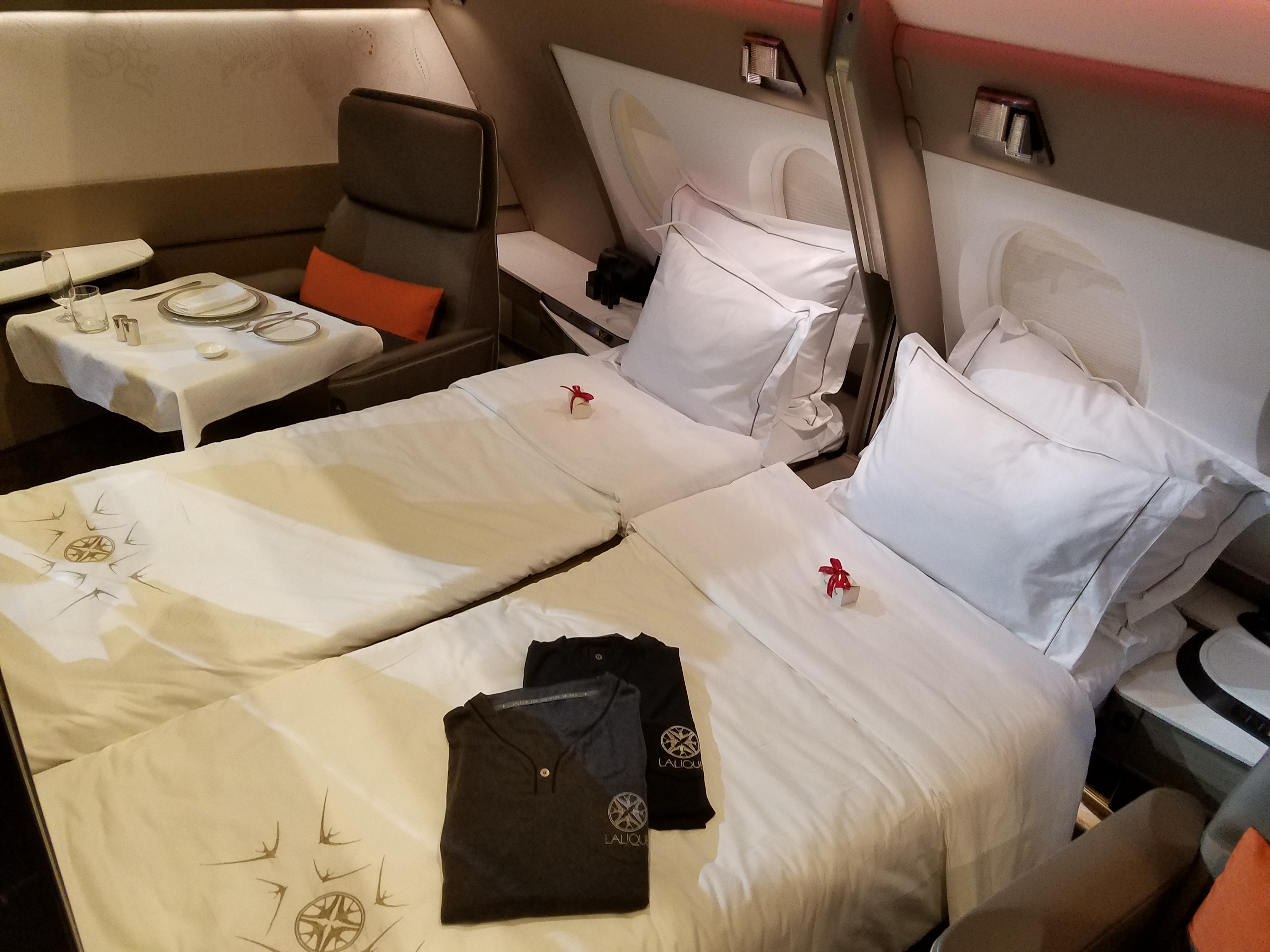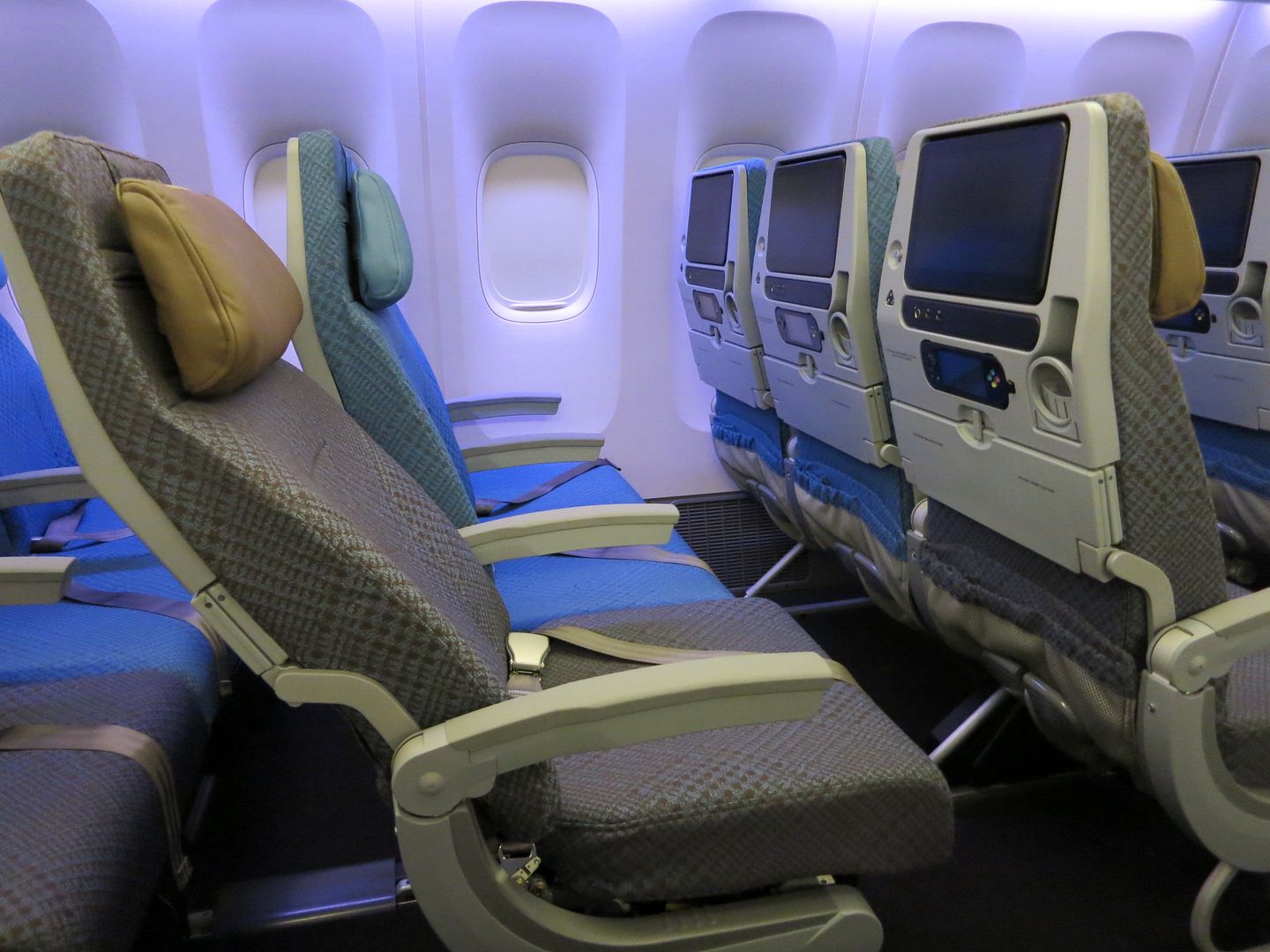I woke up this morning to a new global ad campaign from Singapore Airlines called “World Class” and it’s amazing for reasons that they don’t describe in their release.
The campaign video shows a Singapore Airlines flight attendant connecting with people and cultures in her travels around the world. It’s this personal connection that allows the airline to deliver world class service every day. That’s not the real message of this campaign and this video.
The imagery from Barcelona, Mumbai, Singapore, Auckland and Shanghai is great. And showing a flight attendant traveling the world and bringing back her discoveries to the cabin was the crux of the airline’s fantastic “The Lengths We Go” 10 years ago, for instance attending a film festival in India and picking out movies for the KrisFlyer entertainment system, or serving tea on board discovered during thee travels.
Ignore the exoteric meaning of the campaign, and dig deeper for a more Straussian esoteric meaning. Look to the specific language in the video, and the cabin imagery.
It’s the unexpected six star hospitality, rather than a five star badge.
Because while first class is something you can buy, world class is everything we do.
The five star badge seems clearly aimed at Gulf carriers. In 2019 Etihad lost its 5 star rating from Skytrax, then a year and a half later is awarded a 5 star badge by APEX. Emirates also has 5 stars from APEX. I take Singapore’s point about these badges, in 2018 American Airlines was elevated to 5 stars by APEX as well.
Singapore Airlines is saying they’re real quality, in their DNA, they do the hard work and invest in the details. They built a model Airbus A380 using manila envelopes and the seats inside the plane even reclined. Dig beneath the surface and all the hidden details get attention. Tag line: “It’s the small details that make giants in the sky.”
It’s an ethic that was emphasized in the Walter Isaacson biography of Steve Jobs, a belief (probably imbued as a young child by his father) that the internal workings nobody sees have to be just as high quality as everything on the surface. It’s no wonder that both Singapore Airlines and Apple are iconic brands.
After declaring the difference between first class (where you pay extra for a specific quality) and world class (where everything is quality), the video declares “Welcome to World Class” and they don’t show their Suites as emblematic of what that means. Instead they present a flight attendant standing in the aisle of economy. It’s their people and they are proud of their entire product.

Singapore offers amazing premium services – from their Suites with separate seat and bed, outstanding main meal service and wine program, not to mention excellent Lalique amenity kits – can legitimately brag about its coach service.

While Emirates uses an over-the-top first class product as a halo to mask an inferior business class, Singapore offers little touches even in the economy cabin.
Singapore offers more legroom than you’ll find on US airlines. But it goes beyond a basic seat. Coach gets a six-way adjustable headrest, and a padded seat for back support, as well as an adjustable foot bar (that’s something you get in premium economy usually on a U.S. carrier and not even domestic first class). Their coach seat has a cup holder and coat hook, and pouch for your phone that’s convenient to charging ports along with a large 11.1 inch touch screen video for watching their KrisFlyer entertainment system.
In economy you receive a pillow and a blanket, and they’re reasonable sized not postage-stamp sized. And while I haven’t checked in on their coach food in recent months, they always served the same meals in economy that they offered to premium economy passengers (though premium economy gets more choices and pre-order options, plus larger portions). Economy class passengers are served food I’d actually eat.

The real message of this campaign is, consistent with Singapore Airlines messaging over the last decade, they go to great lengths, invest in the details, and that shows up across their entire product. You can dig beneath the surface and find deep quality.


Wow, you really thought about this. Good analysis. I just scanned and deleted the email.
SQ has always had to overcompensate to make up for Singapore’s poor location to be a hub. Much more of the world’s traffic logically flows over the Middle East than over Singapore.
It is Singapore’s own geography – at the ” bottom” of the Pacific rim that makes it subject to having its traffic picked off by other carriers.
and yet the Middle East carriers are trying to pick traffic off of the European and East Asia legacy carriers as the bulk of their networks.
Having lower cost labor than the carriers they compete with makes both strategies viable.
SQ has a great product but let’s not fail to dig deeper to why both strategies exist
@Tim Dunn it’s not quite true to say that “SQ has always had to overcompensate to make up for Singapore’s poor location to be a hub.” Your memory is short, because there was a time when Dubai wasn’t a long haul mega hub and when there wasn’t as much long haul point-to-point either.
Singapore *is* geographically challenged as a connecting point for North America. Non-stops with modern aircraft (not just flying gas cans) help a little bit here. However *Cathay Pacific*’s geographic advantage is being eroded by a geopolitical disadvantage, with regional finance shifting someone out of Hong Kong. Singapore should benefit from more O/D traffic at least.
Ultimately saying ‘they’re a premium carrier because they need to be’ fails because they could just as easily have gone the other direction, being the low cost leader ‘because they need to be’. Every airline chooses a strategy that matches the hand they’re dealt, but often isn’t the only possible strategy they might employ.
Gary,
SQ has still had to compete with carriers further “up” the Pacific hub which can pick off traffic – in Japan (the traditional transpacific gateway), S. Korea and China. And, yes, HKG has played that role but S. Korea is becoming an even stronger transpacific hub.
The ME3 have been around for a quarter of a century.
And SQ also has operated many 5th freedom routes where they have had to compete with local carriers.
and SQ has invested in the low cost carrier segment but has worked very hard to keep the brands separate.
Yes, SQ has overcompensated because of their geography. They have made it work but let’s not act like the ME3 are the first and only reason that SQ has ever had to be world class.
Their ULR A350 flights do not even have SQ’s best product because they use the nonstop factor.
@Tim Dunn of course elsewhere in Asia matters but your Delta bias shows prioritizing Seoul in this discussion, Tokyo is less important here than it used to be and not because of Seoul. Before the pandemic China was taking on a greater role because of overexpansion by their carriers as they squatted routes. The ‘five star’ comment by SQ was clearly aimed at Gulf carriers in any case.
Singapore has positioned itself well with the assets they had – remember they were effectively kicked out of Malaysia and had very little look at what has been built! And the airline has been a significant part of that.
There is no Delta bias.
Seoul is a larger hub in the transpacific connecting world BECAUSE China and HKG will never return to the place they once had and because the Japanese carriers and their US partners are trying to operate split hubs in Tokyo which combined do not serve as much of Asia as Seoul does.
and once the KE/OZ merger is finalized, Seoul will become an even larger part of part of transpacific connecting traffic.
None of which changes that Singapore is a poor hub for either east-west or north-south traffic flows to/from the Pacific rim.
I have never said that SQ doesn’t run a great operation and offer a great product.
I am simply not buying your notion that the reason for SQ’s success is solely because it competes (quite well) with the ME3.
@Tim Dunn – “I am simply not buying your notion that the reason for SQ’s success is solely because it competes (quite well) with the ME3.”
Where did I write this?
“The five star badge seems clearly aimed at Gulf carriers.”
SQ is a fine airline. They were so before the ME3. They are good because they have to overcome certain geographic limitations which impact hub geography- and they do it.
There is no reason to focus any more attention on the ME3 than for any other reasons why SQ has to overperform or the fact that they overperform in markets where the ME3 don’t effectively compete.
They are a high quality largely niche airline serving a market that is much smaller than other parts of the world. but they are a high quality airline trying to distinguish themselves.
We flew Singapore Airlines recently to Hong Kong from San Francisco and this exposed their main liability of having their one and only hub in Singapore. 16 hours from San Francisco to Singapore, 2 hour layover and then another 3-4 hours to Hong Kong. Total travel time, 20+ hours! We flew both premium economy and business class, in flight services were great, and each class product were in line with costs. However, Singapore Airlines’ customer phone support centers, were consistently subpar and their App performance left much to be desired. Given other choices, we would not fly them to Asia again unless we are flying into Singapore.
Reclining sheets of the bane of my existence. I always get behind the person that puts their seat back the whole way the minute they sit down and I can’t even enjoy a snack because my table won’t extend because their face is in my lap.
@Tim Dunn you are clearly reading something in that sentence that isn’t there.
“The five star badge seems clearly aimed at Gulf carriers” is not “the reason for SQ’s success is solely because it competes (quite well) with the ME3.”
Tony just validated my point
ME3 is not a competitor in the market he flew
You guys are very North America focused. Singapore is a terrific hub from where I sit…Australia. It has always been a popular transit hub for the south west pacific and south east Asia into Europe, and Africa but also to the rest of Asia as well as into North America for the people of Perth and Jakarta for example. .
Indeed SQ has become the de facto national carrier for lots of Aussies despite stiff competition from ME3 and QF. Great product and scheduling.
Nevertheless, I also agree that SQ hasn’t addressed the ‘detail’ in the call centres. They’re horrible to deal with. Importantly they’re often the first customer facing contact a pax makes with the airline. So bad first impressions count. Recently I had to push to get the agent to recognise *Alliance redemptions were possible!
@TomK – No one says SIN isn’t well-positioned *for anyone* and I very much had Australia in mind, but there simply aren’t very many Australians.
2Sue Ryan “…my table won’t extend because their face is in my lap.” Now that’s some seat recline. That wouldn’t be a bit of hyperbole would it? 😉
The one thing that would have me consider Singapore Air if flying coach: 9 across on their B777. I abhor 10 across. I flew it one time on AA LHR-LAX 7 years ago and have been actively avoiding it ever since. Sadly DL retired their 9 across B777s.
A few thoughts:
@ Tim Dunn might consider the population of Indonesia (275 million) before trivialising the geographical position of Singapore.
@ Gary Leff might consider tourist and business air traffic before trivialising the population size of Australia – go check out the numbers of SQ flights per day…;)
If the marketing campaign requires analysis for us to grasp its inner meaning, then arguably its message is wasted on the majority of its audience. More likely its message is simple and some want to over think it…;)
Much US-centric commentary there is (putting it politely).
@platy I am well aware of the size of the air travel market in Australia. That’s great. Until you compare it to other markets.
Australia to the rest of the world is a small fraction of global air travel. It is booming now because of QF’s strategic failures and Virgin Australia’s withdrawal from longhaul international widebody flights and so other carriers are doing all they can to take advantage
Indonesia is also relatively small as a global travel market. Population does not equate to longhaul travel demand. SQ, on its flagship airline, has far larger markets than Indonesia. Scoot is intended to help SQ participate in the short haul low cost carrier market in SE Asia.
@ Gary Leff
Cool, mate…so it isn’t about population…;)
For the information of your readers, SQ / Scoot run upwards of 20 flights per day between Singapore and Australia:
SQ Widebody:
SIN-BNE 3x daily
SIN-SYD 4x daily
SIN-MEL 4x daily
SIN-ADL 1x daily
SIN-PER 3x daily
SIN-ADL 1x daily
SQ MAX:
SIN-DRW 3x weekly
SIN-CNS 3x weekly
Scoot 787:
SIN-SYD 1/2x daily
SIN-MEL 1/2x daily
SIN-PER 1/2x daily
SIN-OOL 3x weekly
Be well, all…
@ Tim Dunn
I thought we were talking about Singapore and not the whole planet?
Yes, of course ME is well placed geographically with the claim that 33% world population within 4-hour flight radius and 80% world population in 12 hour radius. The competition in specific markets can be debated to any level of detail.
And, yes, I tend to agree that SQ established its brand credentials before the ME3s’ expansion.
FWIW, VA was never a serious player in any long haul international market (with its own metal).
But yes, the international strategy at QF arguably leaves it relegated to being a niche player with lacklustre financial results in that division. It’s currently lurching from one PR disaster to another, nearly on a daily basis.
Exactly @platy…South West Pacific (adding NZ to the mix) is a primary market for SQ.
@platy…Looks like there are more SQ flights from South West Pacific than North America hey? I’m including New Zealand which is served twice daily from AKL and daily from CHC. 🙂
South West Pacific is a primary market for SQ. There’s a reason the very first scheduled revenue flight of SQ’s A380 was to SYD.
I recently flew SIN – SFO on premium economy. Amenity kit was not given and I thought the food was underwhelming compared to the Gulf carriers.
So last night I showed this ad to my wife, after which I explained Gary’s analysis of the ad. She looked at me blankly and said “Oh, I thought they were just rebranding economy class as “World class”. LOOOOOL. Now I look at the ad in a whole different way!
OK, lets actually quote some statistics- going by passenger traffic volume, 2019 being the last fair year to measure-
– Singapore is 18th, with 68M passengers
– Seoul Incheon is 14th with 71M passengers
– Dubai is 27th with 29M
– Sydney is 49th with 44M
– Narita is 50th with 44M.
No where could I find transit-only passengers, though you would think adjusting for that would shoot Dubai up the rankings, though probably not past Singapore/Seoul. If you eliminate domestic traffic, Singapore’s probably the biggest.
Now back to the original topic of this thread- SQ advertising and delivery vs promise. Unfortunately, cool new ads, but I think the delivery of service has definitely dropped post covid. Planes are packed, so I would excuse the attendant attention, but the food quality has definitely dropped in economy- last flight was so bad, I thought I was on United!